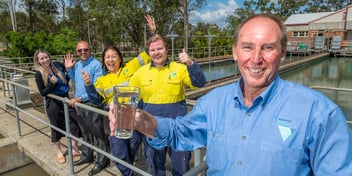How biochar is helping two utilities with their circular economy goals

Carbon-rich biochar is also rich with opportunity, and two utilities have shared with an Ozwater'22 audience their two different approaches to harnessing the resource to help drive towards the circular economy.
“Water utilities are in a unique position to lead the way in adaptation and resilience in the circular economy,” said Johanna Johnson, Sustainable Projects Lead for Logan Water at Logan City Council.
Products like Logan Water’s biochar, which is produced by converting sewage sludge to biosolids through dewatering, then putting the resulting product through a gasification process at temperatures between 650 and 800 degrees Celsius to form small dry pellets, have a range of uses, particularly in the agricultural industry as a fertiliser.
They could also be used in industrial combustors as fuel and feedstock, and as activated carbon.
“The biochar product is also inert, so it doesn’t generate odours,” Johnson said — and to prove it, she had brought along a sample for the standing-room only audience to examine.
“I can actually pass it around and not cause anyone to quickly leave the room.”
Gasification is a method of thermally treating organic mass, such as biosolids, converting it into carbon monoxide, hydrogen and carbon dioxide, which are then used in a heat exchanger to dry the biochar.
“This is achieved by the materials acting at high temperatures without combustion and in a controlled amount of oxygen,” Johnson explained.
“Gasification … destroys persistent organic pollutants and microplastics and nanoplastics, but what's really great is that it can retain your macro nutrients like phosphorus and potassium. What that means is that it’s actually really great as a soil ameliorant.”
The gasification process has a range of other advantages as well, she said, including destroying the per- and polyfluoroalkyl substances (PFAS) in the biosolids, and the removal of microplastics and nanopollutants from the environment by embedding them in the biochar.
“We were able to show that with gasification we can achieve a 64 per cent reduction in microplastics,” Johnson said.
“There's also been studies that show that they became sequestered into the carbon as well, meaning that doesn't go back into the agricultural system.”
Systems thinking
Processes like this allow the council to change its view of treatment plants from places of waste disposal to sites of production: resource recovery hubs with the potential to produce biochar, as well as water, energy, nutrients and minerals.
And because the biochar sequesters carbon, its production plays an important role in helping Logan City Council achieve its carbon neutrality goals.
“What this has done has given us an economic basis to view carbon emissions and a strategic plan on how we can achieve carbon neutrality in the short term, not only for Logan Water but the council,” said Johnson
“We don't have to look at purchasing our own carbon credits to achieve carbon neutrality for 2022.”
Alternative approach
Victorian utility South East Water has also been making strides in biochar production, as Biosolids Program Manager Dr Aravind Surapaneni discussed during his Ozwater'22 presentation.
Unlike Logan Water’s gasification approach, South East Water’s approach used pyrolysis to convert biosolids into biochar.
Pyrolysis is an endothermic process that converts biosolids to biochar at high heat in an inert environment. South East Water used Pyroco, a process developed at RMIT University, and the material it produced in the utility’s trial had 36 grams of phosphorus per kilogram and 18 grams of available nitrogen, and no detectable PFAS — making it suitable as a fertisiliser.
“Biochars are high in phosphorus and potassium; not only that, they're also high in sulphur, and magnesium and calcium,” Surapaneni said.
“Our novel pyrolysis technology has a huge potential to provide value options for biosolids management in Australia … converting biosolids into a valuable product — not only valuable, but also safe.”
For more on biosolids, check out the Australian and New Zealand Biosolids Partnership (ANZBP).

